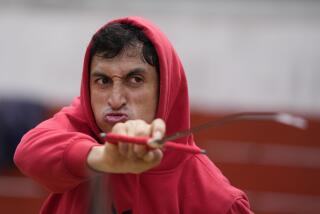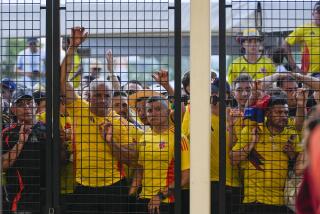Colombia Youth Dream of Bullring Fame : Matador school: Poor youngsters hope to better their fate as idols have done, including one who earns $120,000 per fight. But odds are long, and their lives depend on learning it right.
- Share via
BOGOTA, Colombia — As the morning rush hour reaches a dull roar, the boys in Bogota’s bullring are deep in concentration, hearing only the bellowing of a bull, a cape sweeping across the sand, the roar of applause.
But no bulls are rushing across the arena. The stands are empty.
The boys, students at Bogota’s bullfighting school, dream of joining Colombia’s growing ranks of internationally famous matadors. Inspired by superstar Cesar Rincon, they want to escape their poor barrios and prove their bravery and grace before paying crowds.
The company that runs the bullring, the Plaza de Toros Santamaria, opened the free school two years ago, to give fans a wider variety of matadors and to meet a municipal law that requires the company to invest some profits in the city.
The 17 students--selected by school director Pablo Becerra for fitness and mental discipline--arrive when the arena is still enveloped in cool shade.
One 13-year-old doffs his cap with studied formality to greet an imaginary crowd upon entering the ring, built in the 1930s when Bogota was a placid town. Office and apartment buildings now tower overhead.
As the sun, warm in the thin Andean air, climbs above the bullring, the students raptly focus their attention on swinging their capes--ripped in places and mended with electrical tape. The circular wall of red bricks mutes the traffic, creating an oasis of calm in this city of 7 million people.
When the students run at each other with horns mounted on wheels, Becerra, a 47-year-old retired matador with the build of a wrestler, calls out tips.
Students pass their capes before the horns--taken from bulls slain in the arena--and pirouette away.
“Slow it down,” Becerra shouts to one, explaining that bulls attack movement. The less a bullfighter moves, the safer he will be. As he talks, Becerra leans on a wooden barrier pitted by the horns of angry bulls.
The students, who practice with silver-painted wooden swords, imagine they are facing 1,000 pounds of horned fury, knowing their lives depend on learning it right.
“Bullfighting is an art,” said Carlos Gutierrez, 16. “It’s not like anything else. Not like soccer or basketball. You’re risking your life.”
The first time Gutierrez fought a bull, a small one, he was overconfident. The bull butted him to the ground and pummeled him into unconsciousness.
The school is held in the mornings, so the students can attend regular school in the afternoons.
The odds are against many becoming more than journeymen bullfighters. But Becerra has high hopes for Jose Ignacio Paez, a talented 13-year-old who lives with his mother and grandmother in a gritty neighborhood.
“I know it’s not going to be easy to reach Rincon’s level,” said Jose, beefed up from daily workouts and with a demeanor much more serious than other boys. “You must push yourself to become better than you’re capable of being.”
Budding matadors work in Colombia’s bullfighting circuit and seek success in Spain, bullfighting’s mecca. Their role models are Colombians who have attained international status, including Jorge Herrera, Cesar Camacho, Nelson Segura and Jose Gomez.
Rincon, the king of Colombian bullfighters, is idolized in the bullfighting world. Born to an impoverished family, he earns $120,000 for a night’s work in Spain.
The students know the risks. On the right thigh of Ricardo Garzon, a young bullfighter working out with Becerra, is an inch-wide, foot-long scar.
On Sept. 29, 1993, Garzon tried to crowd a bull in a bit of showmanship in a small bullring near Madrid. The bull plunged a horn into Garzon’s thigh, nicking his femoral artery, then gored him in the buttocks as he lay on the sand.
“I was in a pool of my own blood,” Garzon said. “I almost died.”
As Garzon described the injury, some students taking a breather nearby stared at his scar.
Then they picked up their ragged capes and wooden swords and went back to practice.
More to Read
Sign up for Essential California
The most important California stories and recommendations in your inbox every morning.
You may occasionally receive promotional content from the Los Angeles Times.













